
In early August, International Crane Foundation veterinarian Dr. Barry Hartup participated in his third annual research trip to western Canada to band wild Whooping Crane chicks on their remote summering area at Wood Buffalo National Park.


The team was very successful despite the challenges of an intense fire season – about 6% of the park has burned this year, compared to the normal yearly average of 1%. Fortunately, the crane nesting areas have not been directly impacted by the fires, but the effects of the dry conditions on the wetlands were apparent. The team captured ten birds in 11 attempts, which set a record success rate over the past three years (above, Barry with a feisty Whooping Crane chick!). All of the captured chicks were healthy, and the team was able to confirm the reunion of the chick with parents in three out of three families they checked on after capture.
In total, the project has banded and sampled 31 chicks over the past three seasons. The last effort will include an attempt to capture Whooping Cranes on Matagorda Island at the Aransas National Wildlife Refuge this coming December (read our field updates on the 2011 captures).
What We Have Learned
![]() The ten banded chicks are among the newest members of the last naturally occurring Whooping Crane flock, which currently numbers just under 300 birds. The team will track the banded cranes this fall as they migrate south to their wintering area along the Gulf Coast of Texas at the Aransas National Wildlife Refuge, to learn more about their migration routes and possible causes of mortality. The figure to the right shows the migration corridor (shaded gray) and stopover sites (white circles) of 25 Whooping Cranes that were previously banded and tracked during the 2012 spring migration (click on figure to enlarge).
The ten banded chicks are among the newest members of the last naturally occurring Whooping Crane flock, which currently numbers just under 300 birds. The team will track the banded cranes this fall as they migrate south to their wintering area along the Gulf Coast of Texas at the Aransas National Wildlife Refuge, to learn more about their migration routes and possible causes of mortality. The figure to the right shows the migration corridor (shaded gray) and stopover sites (white circles) of 25 Whooping Cranes that were previously banded and tracked during the 2012 spring migration (click on figure to enlarge).
Between 40-60% of deaths in this Whooping Crane population may occur during migration, so this is a critical time to track the birds to learn about possible threats, such as collisions with power lines or disease. These data will also help researchers identify important stop-over areas along the migration route, which will help inform future plans for conservation along this corridor in western Canada and the United States (see table below).

The Whooping Crane Tracking Partnership is comprised of the Canadian Wildlife Service, Crane Trust, U.S. Fish and Wildlife Service, Platte River Recovery Implementation Program, and U.S. Geological Survey, with support from the Gulf Coast Bird Observatory, International Crane Foundation and Parks Canada.
